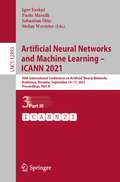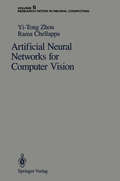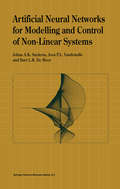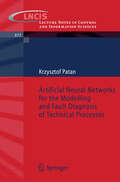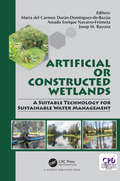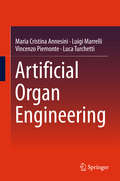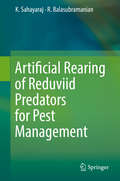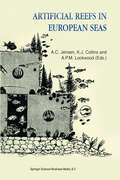- Table View
- List View
Artificial Neural Networks: Methods and Applications in Bio-/Neuroinformatics (Springer Series in Bio-/Neuroinformatics #4)
by Petia Koprinkova-Hristova Nikola K. Kasabov Valeri MladenovThe book reports on the latest theories on artificial neural networks, with a special emphasis on bio-neuroinformatics methods. It includes twenty-three papers selected from among the best contributions on bio-neuroinformatics-related issues, which were presented at the International Conference on Artificial Neural Networks, held in Sofia, Bulgaria, on September 10-13, 2013 (ICANN 2013). The book covers a broad range of topics concerning the theory and applications of artificial neural networks, including recurrent neural networks, super-Turing computation and reservoir computing, double-layer vector perceptrons, nonnegative matrix factorization, bio-inspired models of cell communities, Gestalt laws, embodied theory of language understanding, saccadic gaze shifts and memory formation, and new training algorithms for Deep Boltzmann Machines, as well as dynamic neural networks and kernel machines. It also reports on new approaches to reinforcement learning, optimal control of discrete time-delay systems, new algorithms for prototype selection, and group structure discovering. Moreover, the book discusses one-class support vector machines for pattern recognition, handwritten digit recognition, time series forecasting and classification, and anomaly identification in data analytics and automated data analysis. By presenting the state-of-the-art and discussing the current challenges in the fields of artificial neural networks, bioinformatics and neuroinformatics, the book is intended to promote the implementation of new methods and improvement of existing ones, and to support advanced students, researchers and professionals in their daily efforts to identify, understand and solve a number of open questions in these fields.
Artificial Neural Networks and Machine Learning – ICANN 2021: 30th International Conference on Artificial Neural Networks, Bratislava, Slovakia, September 14–17, 2021, Proceedings, Part III (Lecture Notes in Computer Science #12893)
by Igor Farkaš Paolo Masulli Sebastian Otte Stefan WermterThe proceedings set LNCS 12891, LNCS 12892, LNCS 12893, LNCS 12894 and LNCS 12895 constitute the proceedings of the 30th International Conference on Artificial Neural Networks, ICANN 2021, held in Bratislava, Slovakia, in September 2021.* The total of 265 full papers presented in these proceedings was carefully reviewed and selected from 496 submissions, and organized in 5 volumes.In this volume, the papers focus on topics such as generative neural networks, graph neural networks, hierarchical and ensemble models, human pose estimation, image processing, image segmentation, knowledge distillation, and medical image processing. *The conference was held online 2021 due to the COVID-19 pandemic.
Artificial Neural Networks and Machine Learning – ICANN 2021: 30th International Conference on Artificial Neural Networks, Bratislava, Slovakia, September 14–17, 2021, Proceedings, Part IV (Lecture Notes in Computer Science #12894)
by Paolo Masulli Stefan Wermter Igor Farkaš Sebastian OtteThe proceedings set LNCS 12891, LNCS 12892, LNCS 12893, LNCS 12894 and LNCS 12895 constitute the proceedings of the 30th International Conference on Artificial Neural Networks, ICANN 2021, held in Bratislava, Slovakia, in September 2021.* The total of 265 full papers presented in these proceedings was carefully reviewed and selected from 496 submissions, and organized in 5 volumes.In this volume, the papers focus on topics such as model compression, multi-task and multi-label learning, neural network theory, normalization and regularization methods, person re-identification, recurrent neural networks, and reinforcement learning. *The conference was held online 2021 due to the COVID-19 pandemic.
Artificial Neural Networks for Computer Vision (Research Notes in Neural Computing #5)
by Yi-Tong Zhou Rama ChellappaThis monograph is an outgrowth of the authors' recent research on the de velopment of algorithms for several low-level vision problems using artificial neural networks. Specific problems considered are static and motion stereo, computation of optical flow, and deblurring an image. From a mathematical point of view, these inverse problems are ill-posed according to Hadamard. Researchers in computer vision have taken the "regularization" approach to these problems, where one comes up with an appropriate energy or cost function and finds a minimum. Additional constraints such as smoothness, integrability of surfaces, and preservation of discontinuities are added to the cost function explicitly or implicitly. Depending on the nature of the inver sion to be performed and the constraints, the cost function could exhibit several minima. Optimization of such nonconvex functions can be quite involved. Although progress has been made in making techniques such as simulated annealing computationally more reasonable, it is our view that one can often find satisfactory solutions using deterministic optimization algorithms.
Artificial Neural Networks for Engineers and Scientists: Solving Ordinary Differential Equations
by S. Chakraverty Susmita MallDifferential equations play a vital role in the fields of engineering and science. Problems in engineering and science can be modeled using ordinary or partial differential equations. Analytical solutions of differential equations may not be obtained easily, so numerical methods have been developed to handle them. Machine intelligence methods, such as Artificial Neural Networks (ANN), are being used to solve differential equations, and these methods are presented in Artificial Neural Networks for Engineers and Scientists: Solving Ordinary Differential Equations. This book shows how computation of differential equation becomes faster once the ANN model is properly developed and applied.
Artificial Neural Networks for Engineers and Scientists: Solving Ordinary Differential Equations
by S. Chakraverty Susmita MallDifferential equations play a vital role in the fields of engineering and science. Problems in engineering and science can be modeled using ordinary or partial differential equations. Analytical solutions of differential equations may not be obtained easily, so numerical methods have been developed to handle them. Machine intelligence methods, such as Artificial Neural Networks (ANN), are being used to solve differential equations, and these methods are presented in Artificial Neural Networks for Engineers and Scientists: Solving Ordinary Differential Equations. This book shows how computation of differential equation becomes faster once the ANN model is properly developed and applied.
Artificial Neural Networks for Intelligent Manufacturing (Intelligent Manufactoring Series)
by C. H. DagliThe quest for building systems that can function automatically has attracted a lot of attention over the centuries and created continuous research activities. As users of these systems we have never been satisfied, and demand more from the artifacts that are designed and manufactured. The current trend is to build autonomous systems that can adapt to changes in their environment. While there is a lot to be done before we reach this point, it is not possible to separate manufacturing systems from this trend. The desire to achieve fully automated manufacturing systems is here to stay. Manufacturing systems of the twenty-first century will demand more flexibility in product design, process planning, scheduling and process control. This may well be achieved through integrated software and hardware archi tectures that generate current decisions based on information collected from manufacturing systems environment, and execute these decisions by converting them into signals transferred through communication network. Manufacturing technology has not yet reached this state. However, the urge for achieving this goal is transferred into the term 'Intelligent Systems' that we started to use more in late 1980s. Knowledge-based systems, our first efforts in this endeavor, were not sufficient to generate the 'Intelligence' required - our quest still continues. Artificial neural network technology is becoming an integral part of intelligent manufacturing systems and will have a profound impact on the design of autonomous engineering systems over the next few years.
Artificial Neural Networks for Modelling and Control of Non-Linear Systems
by Johan A.K. Suykens Joos P.L. Vandewalle B.L. de MoorArtificial neural networks possess several properties that make them particularly attractive for applications to modelling and control of complex non-linear systems. Among these properties are their universal approximation ability, their parallel network structure and the availability of on- and off-line learning methods for the interconnection weights. However, dynamic models that contain neural network architectures might be highly non-linear and difficult to analyse as a result. Artificial Neural Networks for Modelling and Control of Non-Linear Systems investigates the subject from a system theoretical point of view. However the mathematical theory that is required from the reader is limited to matrix calculus, basic analysis, differential equations and basic linear system theory. No preliminary knowledge of neural networks is explicitly required. The book presents both classical and novel network architectures and learning algorithms for modelling and control. Topics include non-linear system identification, neural optimal control, top-down model based neural control design and stability analysis of neural control systems. A major contribution of this book is to introduce NLq Theory as an extension towards modern control theory, in order to analyze and synthesize non-linear systems that contain linear together with static non-linear operators that satisfy a sector condition: neural state space control systems are an example. Moreover, it turns out that NLq Theory is unifying with respect to many problems arising in neural networks, systems and control. Examples show that complex non-linear systems can be modelled and controlled within NLq theory, including mastering chaos. The didactic flavor of this book makes it suitable for use as a text for a course on Neural Networks. In addition, researchers and designers will find many important new techniques, in particular NLq Theory, that have applications in control theory, system theory, circuit theory and Time Series Analysis.
Artificial Neural Networks for the Modelling and Fault Diagnosis of Technical Processes (Lecture Notes in Control and Information Sciences #Vol. 377)
by Krzysztof PatanAn unappealing characteristic of all real-world systems is the fact that they are vulnerable to faults, malfunctions and, more generally, unexpected modes of - haviour. This explains why there is a continuous need for reliable and universal monitoring systems based on suitable and e?ective fault diagnosis strategies. This is especially true for engineering systems,whose complexity is permanently growing due to the inevitable development of modern industry as well as the information and communication technology revolution. Indeed, the design and operation of engineering systems require an increased attention with respect to availability, reliability, safety and fault tolerance. Thus, it is natural that fault diagnosis plays a fundamental role in modern control theory and practice. This is re?ected in plenty of papers on fault diagnosis in many control-oriented c- ferencesand journals.Indeed, a largeamount of knowledgeon model basedfault diagnosis has been accumulated through scienti?c literature since the beginning of the 1970s. As a result, a wide spectrum of fault diagnosis techniques have been developed. A major category of fault diagnosis techniques is the model based one, where an analytical model of the plant to be monitored is assumed to be available.
Artificial Neural Networks in Cancer Diagnosis, Prognosis, and Patient Management
by R. N. G. Naguib G. V. SherbetThe potential value of artificial neural networks (ANN) as a predictor of malignancy has begun to receive increased recognition. Research and case studies can be found scattered throughout a multitude of journals. Artificial Neural Networks in Cancer Diagnosis, Prognosis, and Patient Management brings together the work of top researchers - primaril
Artificial Neural Networks in Cancer Diagnosis, Prognosis, and Patient Management
by G. V. Sherbet R. N. G. NaguibThe potential value of artificial neural networks (ANN) as a predictor of malignancy has begun to receive increased recognition. Research and case studies can be found scattered throughout a multitude of journals. Artificial Neural Networks in Cancer Diagnosis, Prognosis, and Patient Management brings together the work of top researchers - primaril
Artificial Neural Networks in Pattern Recognition: 10th IAPR TC3 Workshop, ANNPR 2022, Dubai, United Arab Emirates, November 24–26, 2022, Proceedings (Lecture Notes in Computer Science #13739)
by Neamat El Gayar Edmondo Trentin Mirco Ravanelli Hazem AbbasThis book constitutes the refereed proceedings of the 10th IAPR TC3 International Workshop on Artificial Neural Networks in Pattern Recognition, ANNPR 2022, held in Dubai, UAE, in November 2022. The 16 revised full papers presented were carefully reviewed and selected from 24 submissions. The conference presents papers on subject such as pattern recognition and machine learning based on artificial neural networks.
Artificial Neural Networks in Vehicular Pollution Modelling (Studies in Computational Intelligence #41)
by Mukesh Khare S.M. Shiva NagendraThis book provides a step-by-step procedure for formulation and development of Artificial Neural Networks based Vehicular pollution models. It takes into account meteorological and traffic aspects. The book will be useful for professionals and researchers working in problems associated with urban air pollution management and control
Artificial Nucleases (Nucleic Acids and Molecular Biology #13)
by Marina A. ZenkovaThe development of agents capable of cleaving RNA and DNA has attracted considerable attention from researchers in the last few years, because of the immediate and very important applications they can find in the emerging fields of biotechnology and pharmacology. There are essentially two classes of these agents - nucleases that occur naturally inside cells and synthetically produced artificial nucleases. The first class includes protein enzyme nucle ases and catalytic RNA structured ribozymes that perform cleavage of the phosphodiester bonds in nucleic acids according to a hydrolytic pathway in the course of different biochemical processes in the cell. A different pathway is used by some antibiotics which cleave DNA via redox-based mechanisms resulting in oxidative damage of nucleotide units and breakage of the DNA backbone. The above molecules are indispensable tools for manipulating nucleic acids and processing RNA; DNA-cleaving antibiotics and cytotoxic ribonucleases have demonstrated utility as chemotherapeutic agents. The second class, artificial nucleases, are rationally designed to imitate the active centers of natural enzymes by simple structures possessing minimal sets of the most important characteristics that are essential for catalysis. A dif ferent approach, in vitro selection, was also used to create artificial RNA and DNA enzymes capable of cleaving RNA. Being less efficient and specific as compared to the natural enzymes, the primitive mimics are smaller and robust and can function in a broad range of conditions.
Artificial or Constructed Wetlands: A Suitable Technology for Sustainable Water Management
by María-Del-Carmen Durán-Domínguez-De-Bazua Amado Enrique Navarro-Ómeta Josep M. BayonaArtificial or constructed wetlands are an emerging technology particularly for tropical areas with water scarcity. For big cities, the sustainable management of water resources taking into account proper use is always challenging. The book presents case studies illustrating the above. As plants and microorganisms are a fundamental part of the correct functioning of these systems, their contribution to the degradation of the organic matter and to the removal and transformation of the pollutant compounds present in the wastewaters is also a highlight of this book.
Artificial or Constructed Wetlands: A Suitable Technology for Sustainable Water Management
by María del Carmen Durán-Domínguez-de-Bazúa Amado Enrique Navarro-Frómeta Josep M. BayonaArtificial or constructed wetlands are an emerging technology particularly for tropical areas with water scarcity. For big cities, the sustainable management of water resources taking into account proper use is always challenging. The book presents case studies illustrating the above. As plants and microorganisms are a fundamental part of the correct functioning of these systems, their contribution to the degradation of the organic matter and to the removal and transformation of the pollutant compounds present in the wastewaters is also a highlight of this book.
Artificial Organ Engineering
by Maria Cristina Annesini Luigi Marrelli Vincenzo Piemonte Luca TurchettiArtificial organs may be considered as small-scale process plants, in which heat, mass and momentum transfer operations and, possibly, chemical transformations are carried out. This book proposes a novel analysis of artificial organs based on the typical bottom-up approach used in process engineering. Starting from a description of the fundamental physico-chemical phenomena involved in the process, the whole system is rebuilt as an interconnected ensemble of elemental unit operations.Each artificial organ is presented with a short introduction provided by expert clinicians. Devices commonly used in clinical practice are reviewed and their performance is assessed and compared by using a mathematical model based approach. Whilst mathematical modelling is a fundamental tool for quantitative descriptions of clinical devices, models are kept simple to remain focused on the essential features of each process.Postgraduate students and researchers in the field of chemical and biomedical engineering will find that this book provides a novel and useful tool for the analysis of existing devices and, possibly, the design of new ones. This approach will also be useful for medical researchers who want to get a deeper insight into the basic working principles of artificial organs.
Artificial Organic Networks: Artificial Intelligence Based on Carbon Networks (Studies in Computational Intelligence #521)
by Hiram Ponce-Espinosa Pedro Ponce-Cruz Arturo MolinaThis monograph describes the synthesis and use of biologically-inspired artificial hydrocarbon networks (AHNs) for approximation models associated with machine learning and a novel computational algorithm with which to exploit them. The reader is first introduced to various kinds of algorithms designed to deal with approximation problems and then, via some conventional ideas of organic chemistry, to the creation and characterization of artificial organic networks and AHNs in particular.The advantages of using organic networks are discussed with the rules to be followed to adapt the network to its objectives. Graph theory is used as the basis of the necessary formalism. Simulated and experimental examples of the use of fuzzy logic and genetic algorithms with organic neural networks are presented and a number of modeling problems suitable for treatment by AHNs are described:· approximation;· inference;· clustering;· control;· classification; and· audio-signal filtering.The text finishes with a consideration of directions in which AHNs could be implemented and developed in future. A complete LabVIEW™ toolkit, downloadable from the book’s page at springer.com enables readers to design and implement organic neural networks of their own.The novel approach to creating networks suitable for machine learning systems demonstrated in Artificial Organic Networks will be of interest to academic researchers and graduate students working in areas associated with computational intelligence, intelligent control, systems approximation and complex networks.
Artificial Organs (New Techniques in Surgery Series #4)
by Nadey HakimThis book deals with organ failure and the way it can be managed artificially without requiring a transplant. Written by a mixture of European and US physicians and surgeons, each of the chapters compares the artificial organ to what is currently available from the transplant point of view to highlight the current and modern available techniques for organ replacement. The book will be a useful reading for postgraduate students and people interested in modern surgical and medical technology.
Artificial Organs (Synthesis Lectures on Biomedical Engineering)
by Gerald MillerThe replacement or augmentation of failing human organs with artificial devices and systems has been an important element in health care for several decades. Such devices as kidney dialysis to augment failing kidneys, artificial heart valves to replace failing human valves, cardiac pacemakers to reestablish normal cardiac rhythm, and heart assist devices to augment a weakened human heart have assisted millions of patients in the previous 50 years and offers lifesaving technology for tens of thousands of patients each year. Significant advances in these biomedical technologies have continually occurred during this period, saving numerous lives with cutting edge technologies. Each of these artificial organ systems will be described in detail in separate sections of this lecture.
Artificial Rearing of Reduviid Predators for Pest Management
by K. Sahayaraj R. BalasubramanianThis eye-opening book focuses on the development of techniques to mass-produce reduviid predators and important generalist predators, an endeavor that won’t prove sufficient if the cost of commercialization is prohibitive. Advancing mass production to the level of economic feasibility is critical, so that these new technologies can compete in the open market. This book commences with a review of the diversity of reduviid predators in agro-ecosystems world-wide, followed by chapters on their feeding behavior, biology, gut microbiota, their enzyme profile, body protein and genomics, and DNA and field evaluation reports. The field evaluation of reduviids, a worldwide undertaking, is addressed in the last chapter. Each chapter includes a separate conclusion and future recommendations. Detailed information is also included on ingredients and artificial diet preparation, storage and the impact on predators. The artificial rearing of reduviid predator for crop pest management is an essential reference and teaching tool for teachers, researchers and extension workers in developed and developing countries alike, allowing them to produce reduviid predators and important natural enemies in biocontrol and bio-intensive integrated pest management programs. The book offers an excellent resource for all those who are working on beneficial arthropod mass production. It is also an essential reference guide for agricultural and biological sciences scientists, entomologists, crop protection specialists, extension workers, and consultants.
Artificial Receptors for Chemical Sensors
by Vladimir M. Mirsky Anatoly YatsimirskyThe first to provide systematically organized information on all three important aspects of artificial receptor design, this book brings together knowledge on an exceptionally hot and multidisciplinary field of research. Strong emphasis is placed on the methodology for discovering artificial receptors, with both definitions for chemosensitivity as well as experimental setups supplied. There follows coverage of numerous classes of artificial receptors, including synthesis, immobilization on surfaces, and quantitative data on properties. The third part of the book focuses on receptor arrays for artificial nose and tongue applications and the whole is rounded off with an outlook and an appendix with all relevant quantitative data on artificial receptors.
Artificial Receptors for Chemical Sensors
by Vladimir M. Mirsky Anatoly K. YatsimirskyThe first to provide systematically organized information on all three important aspects of artificial receptor design, this book brings together knowledge on an exceptionally hot and multidisciplinary field of research. Strong emphasis is placed on the methodology for discovering artificial receptors, with both definitions for chemosensitivity as well as experimental setups supplied. There follows coverage of numerous classes of artificial receptors, including synthesis, immobilization on surfaces, and quantitative data on properties. The third part of the book focuses on receptor arrays for artificial nose and tongue applications and the whole is rounded off with an outlook and an appendix with all relevant quantitative data on artificial receptors.
Artificial Reefs in European Seas
by A. P. M.Lockwood, K. J.Collins and A. C.JensenArtificial Reefs in European Seas focuses on artificial reef research in the Mediterranean and NE Atlantic. The book describes most of the long-term projects running in European seas, presents the legal and economic issues, and suggests future uses for artificial reefs in the European context. Readership: Professionals working on or interested in the uses of artificial reefs for fishery management, coastal zone management, aquaculture and nature conservation. The case studies of reef research programmes make the book ideal for degree students studying topics in ecology, and fisheries and coastal management.

